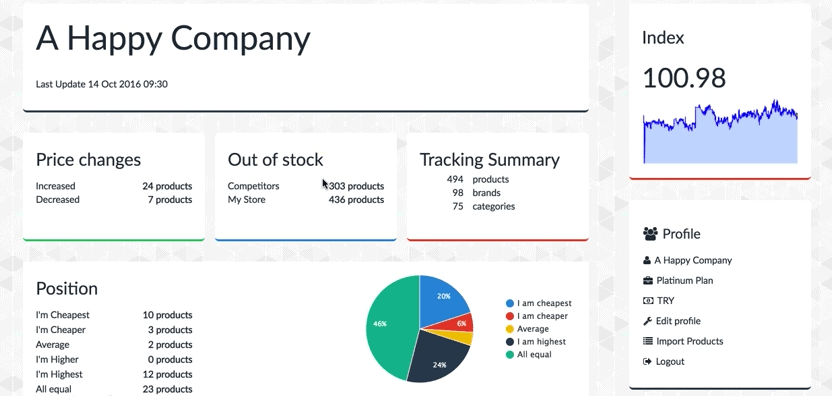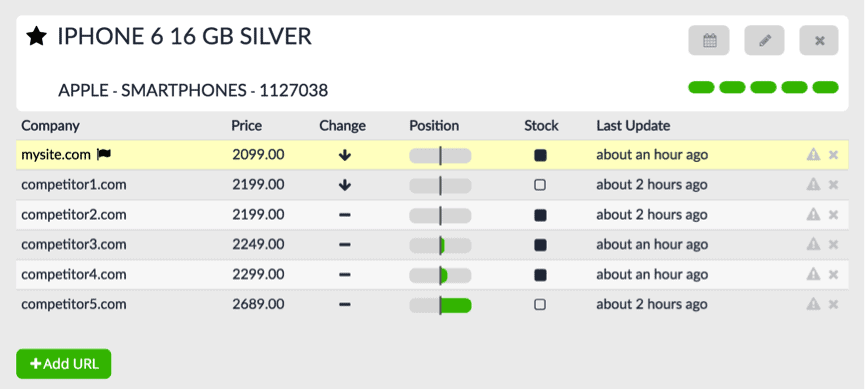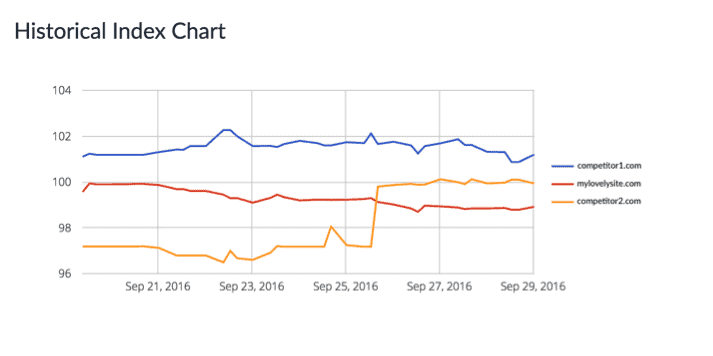Pricing is a team-sport
First of all, any e-commerce company of any size should accept the fact that pricing is a team sport. Therefore, neither the pricing decision-making process nor its analysis affects only a certain department or a person in a certain role. It affects the whole company as the whole company is also affecting it. Price tracking is a task of central importance to e-commerce businesses, but a non-human team member does this task much more efficiently than a human one: competitive pricing intelligence.
It’s a price tracker that should cover the needs of all potential parties within your e-commerce company. Users can vary from product/category managers to business analysts, or from purchasing specialists to the CEO. Therefore, the expected feature set of a competitor price tracking software should also be aligned with all these user groups in mind.
While designing Prisync’s reporting functionality that was the key orientation we had in our minds, and we tried to create a sort of hierarchy of data types to be reported in terms of competitor prices. This means that, along with the raw pricing data, we built various aggregated data types like index values, or other forms of KPIs like for example, a percentage of products that are cheapest in the market.

In addition to designing and crafting various data types, the way the data is being delivered, or let’s say, served also matters and also should be designed in parallel to the needs of the price tracker’s users.
There are many potential ways a business intelligence tool can provide data, and the most common setups are as follows:
- Accessing the data on a plug and play dashboard.

- Exporting data into a CSV or an Excel file and dealing with it in an offline mode if desired.

- Receiving various email notifications/alerts.

- Integrating through a seamless API.

Within Prisync’s competitor price tracker, all these common and most sought after reporting functionalities are readily available as they should be.
Depending on the scale and needs of your e-commerce company, you can either utilize all these reporting channels and data types all at once or can pick one or two of them only within your plan.
Referring to our customer base covering more than 40 countries, the role settings (or let’s say personas) are mostly as follows in parallel with the data channels/types:
- If there are any specific product/category managers, they turn out to be the power users of the Prisync’s web-dashboard along with its e-mail notifications tailored for their own product assortment. These users, drill down their dashboard by applying pricing position filters, checking out frequent price change notifications and adjust their own prices accordingly in a smart way.
- Business analysts, or depending on the size of the company, C-Suite users mainly deal with Prisync’s index analysis, where you see a more aggregated and refined analysis regarding your online pricing performance, like the brands/categories that you are positioned to be cheaper or more expensive vs. competitors in general – instead of checking each and every product’s pricing one by one.

Likewise, such analysis can also be done in a retrospective manner thanks to our historical data logs, where certain discounting patterns of competitors can be identified and reacted against.
- Prisync’s API, which basically delivers all the up-to-date market pricing data available in a Prisync account in JSON format is where our price tracker taps into the hands or minds of the engineering teams/people within an e-commerce company. Integration opportunities are countless thanks to our API’s flexibility and seamless, lightweight nature and sample use cases might be dynamic pricing or other data analytics tool integrations, etc.
Well, in short, a competitor price tracker in use, taps into the workload of almost anybody within an e-commerce company, and so, it can deliver benefits to your company extensively when onboard holistically as briefly depicted above.
In order to get most ROI out of a competitor price tracker, usage of all possible users should be optimized and well designed, and our main concern from this point onwards in this article – after deciding on the team-work around the tool – is to make it crystal clear for you to gain the ultimate benefit from Prisync’s competitor price tracker within only a few days after getting started with it.
Smart price competition for all sizes of e-commerce companies
To start with, we must imply that Prisync’s competitor price tracker is extremely easy to use, both thanks to its design but honestly due to what we actually deal with. How on earth a tool that informs you about competitor prices can be complicated, right?
As part of this tutorial-ish section of the article, once again we’ll keep the users in mind and aim to deliver tips on how those users can specifically utilize Prisync’s competitor price tracker within their workflow.
User/usage type 1: Dynamic price changers
Prisync has 4 daily price update cycles – and more to come – which means that it’s not a weekly or even daily data, but it even gets updated within a day depending on the day-time.
In harshly price competitive segments of e-commerce – if you are in one, you’d understand what we really mean by harsh – it’s not rare to see multiple price changes for a product within a day. Therefore, in order to react upon such pricing actions of competitors, the users who have the control over price changes within your company can view the live price-points within the market any time they log in to their Prisync dashboards and find the sweet spots for pricing their product vs. competitors and adjust their prices.

Alternatively, one can focus on price change alerts sent either on a daily or instantaneous basis and adjust prices according to price movements displayed in the notifications clearly.
However, it should always be kept in mind that, competitive pricing is not just price matching or aiming for the minimum prices all the time. By filtering out products in Prisync’s dashboard, users responsible for price changes can also find out some SKUs with extremely low prices at your own store vs. competitors.

Well, that’s a solid margin lift opportunity as you’d still keep the lowest price position with higher margins, and can save on dollars at every single sale.
If your company aims for less dynamic price changes, say weekly or monthly, relying on Prisync’s Excel reporting would make sense. Excel is – almost – everyone’s favorite spreadsheet application, and it’s extremely easy to play with numbers on it. All the data available in a Prisync account – all price-points for all the SKUs that you inputted – can simply be exported into an Excel file in a structured manner, and say on a weekly basis, certain formulas can be run on the file to decide on the updated weekly price-points to launch. (This is one of the most common use cases we see over at Prisync, btw.)
User/usage type 2: Users who act upon the pricing conditions in the market
A competitor price tracking software does not only bring the opportunity of adjusting your own prices vs. competitors, but it also enables you to make other related decisions like marketing operations or purchasing in a more data-driven, market-aware way.
In e-commerce marketing, it’s a common strategy to rely on particular brands or even specific products by dedicating certain budgets on them. As e-commerce marketing is all about performance, or more specifically, conversions, an overall understanding of the online price points makes perfect sense. 70% of shoppers say competitive pricing is the most important factor influencing them when deciding where to buy from. Therefore, it’s quite clear that a dollar spent on a product with terrible competitive pricing would not perform well at all.
By having access to up-to-date competitive pricing information, e-commerce marketing teams can better decide on the products that they’d achieve higher conversions and more sales and may flow their marketing budgets in that direction.
Additionally, a major dimension of a price is the cost behind it. If you aim for a sustainable e-commerce business, you should be aware of your unit product costs while deciding on your pricing. Therefore, with the exception of certain marketing efforts, the price of a product should be higher than its unit cost.
Therefore, actually one positive side effect of using a competitor price tracker is also to get a better understanding of competitors’ cost structures at brand/category levels. Here, supplier relationships and purchasing specialists come into play.
Every day, we hear more and more from Prisync’s users that are responsible for these operations that, they use their Prisync dashboards or Excel reports in their supplier meetings to imply that they are having disadvantageous unit costs compared to their competitors, to their suppliers.
The power this brings in is clearly visible in negotiation power. Prisync’s category or brand level analytics dashboards, clearly show which e-commerce site has the lowest average prices within that product group.

This also can be further extended historically to spot a certain special deal between your supplier and competitor and you can simply ask for a similar deal from your supplier in your next meeting.
In short, it almost kills the information asymmetry and lets you benefit from this competitive strength in terms of bargaining power at the supply side, or let’s say the cost side of your e-commerce operations.
User/usage type 3: Analysts or C-Suite, i.e. people who aim to discover pricing-related causalities
One of the most straightforward expectations from a business intelligence platform is that it should be able to signal out certain causality relationships that cannot be identified by the unaided eye.
Pricing heavily affects the output of any size of an e-commerce operation. However, e-commerce success does not only depend on pricing, so it’s crucial to laser focus on separate factors deeply and identify the real causes of any sort of business failures (for ex. drop in sales) or wins (for ex. increased market share).
To be able to consider pricing dynamics within the competitive landscape as one of the performance factors, your e-commerce company should muscle up its competitive pricing intelligence. In any size of e-commerce company, there should always be someone taking a look at previous performance data (say, last week, last month or last quarter) and depicting various causal relations to direct things up north.
Prisync’s dashboard, which has the ability to display the overview of the market prices on a well-designed single page, has been a solid material of e-commerce companies’ performance review or planning meetings since its early days of adoption worldwide, no matter what the size of the using company is.
By focusing on the pricing position breakdown of the overall assortment, you can see how many of your products carry the lowest price tag in the market or the highest. You can also see what’s your Prisync Index – which is paving its way to becoming an acknowledged e-commerce KPI worldwide – showing the pricing performance of all your SKUs with respect to the market average, along with its historical fluctuations.

A similar historical trend can be seen for particular brands/categories in your account. When a product group performs worse than usual, you can just visit the respective Prisync report for that brand or category and maybe spot some trends where a particular competitor launched a specific campaign on that category or brand for a period of time, which stole away from your market share.
Another important insight can be also gained by viewing the reports in a more skeptic way. Some price changes by some competitors might have limited or no effect on your sales performances, and noticing that would guide you further on how to react on that specific competitor with its next potential movements. In short, as we stated at the beginning – while picking the competitors to monitor – you can also learn more about your competitors’ pricing strengths or weaknesses as you monitor them.
Conclusion
Well, if you made it this far in this article, you should have been convinced of the power of competitive pricing intelligence in general on e-commerce performance and on what’s in it for your e-commerce company.
We tried to emphasize that, automation enables companies of all sizes to get access to fresh and up-to-date market pricing information, and actions to be taken on such data are limitless within any size of e-commerce companies.
What we experience with Prisync is that, when competitive pricing has been taken as a team-sport and when the competitor price tracking software gets accepted within the company holistically, it really delivers benefits beyond dynamic pricing or price matching capabilities.
By optimizing e-commerce marketing spending, increasing sales volumes and margins for under-performing products with weak prices, competitor price tracking proves itself to be a must for any size of e-commerce companies.
pricing strategies


Leave a Reply